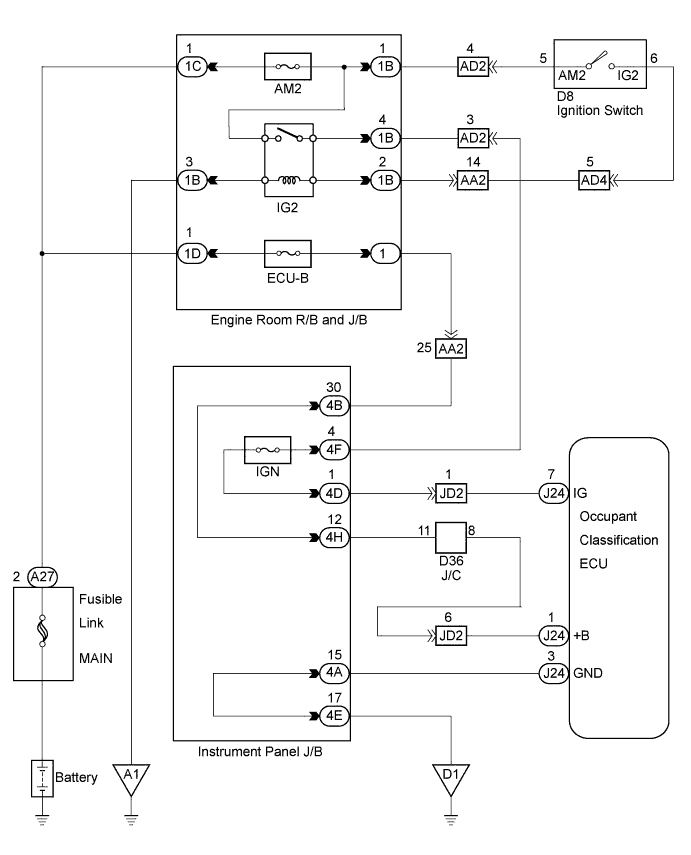CHECK CONNECTION OF CONNECTORS
CHECK WIRE HARNESS (SOURCE VOLTAGE)
REPLACE OCCUPANT CLASSIFICATION ECU
PERFORM ZERO POINT CALIBRATION
DTC B1794 Open in Occupant Classification ECU Battery Positive Line |
DESCRIPTION
DTC B1794 is set when a malfunction is detected in the occupant classification ECU battery positive line.| DTC No. | DTC Detecting Conditions | Trouble Areas |
| B1794 |
|
|
WIRING DIAGRAM

INSPECTION PROCEDURE
| 1.CHECK DTC |
Turn the ignition switch to the on position.
Clear the DTCs stored in the memory (YARIS_NCP93 RM0000010VK06DX.html).
- HINT:
- First clear DTCs stored in the occupant classification ECU and then in the center airbag sensor assembly.
Turn the ignition switch to the lock position, and wait for at least 10 seconds.
Turn the ignition switch to the on position.
Check the DTCs (YARIS_NCP93 RM0000010VK06DX.html).
- OK:
- DTC B1794 is not output.
- HINT:
- DTCs other than B1794 may be output at this time, but they are not related to this check.
|
| ||||
| NG | |
| 2.CHECK CONNECTION OF CONNECTORS |
Turn the ignition switch to the lock position.
Disconnect the negative (-) terminal cable from the battery, and wait for at least 90 seconds.
Check that the connectors are properly connected to the occupant classification ECU.
- OK:
- The connectors are properly connected.
|
| ||||
| OK | |
| 3.CHECK WIRE HARNESS (SOURCE VOLTAGE) |
 |
Turn the ignition switch to the lock position.
Disconnect the negative (-) terminal cable from the battery, and wait for at least 90 seconds.
Disconnect the J24 connector from the occupant classification ECU.
Connect the negative (-) terminal cable to the battery.
Turn the ignition switch to the on position.
Measure the voltage.
- Standard voltage:
Tester Connection Condition Specified Condition J24-1 (+B) - Body ground Ignition switch on 11 to 14 V J24-7 (IG) - Body ground Ignition switch on 11 to 14 V
Measure the resistance.
- Standard resistance:
Tester Connection Condition Specified Condition J24-3 (GND) - Body ground Always Below 1 Ω
|
| ||||
| OK | |
| 4.CHECK DTC |
Turn the ignition switch to the lock position.
Disconnect the negative (-) terminal cable from the battery, and wait for at least 90 seconds.
Connect the connectors to the occupant classification ECU.
Connect the negative (-) terminal cable to the battery.
Turn the ignition switch to the on position.
Clear any DTCs stored in the memory (YARIS_NCP93 RM0000010VK06DX.html).
- HINT:
- First clear DTCs stored in the occupant classification ECU and then in the center airbag sensor assembly.
Turn the ignition switch to the lock position, and wait for at least 10 seconds.
Turn the ignition switch to the on position.
Using the Techstream, check for DTCs of the occupant classification ECU (YARIS_NCP93 RM0000010VK06DX.html).
- OK:
- DTC B1794 is not output.
- HINT:
- DTCs other than B1794 may be output at this time, but they are not related to this check.
|
| ||||
| NG | |
| 5.REPLACE OCCUPANT CLASSIFICATION ECU |
Turn the ignition switch to the lock position.
Disconnect the negative (-) terminal cable from the battery, and wait for at least 90 seconds.
Replace the occupant classification ECU (YARIS_NCP93 RM0000012DU00KX.html).
- HINT:
- Perform the inspection using parts from a normal vehicle when possible.
| NEXT | |
| 6.PERFORM ZERO POINT CALIBRATION |
Connect the negative (-) terminal cable to the battery.
Connect the Techstream to the DLC3.
Turn the ignition switch to the on position.
Using the Techstream, perform the zero point calibration (YARIS_NCP93 RM0000010VN06EX.html).
- OK:
- COMPLETED is displayed on the tester.
| NEXT | |
| 7.PERFORM SENSITIVITY CHECK |
Using the Techstream, perform the sensitivity check (YARIS_NCP93 RM0000010VN06EX.html).
Confirm that nothing is placed on the passenger seat.
Confirm that the beginning sensor reading is within the standard range.
- Standard range:
- -3.2 to 3.2 kg (-7 to 7 lb)
Place a 30 kg (66.14 lb) weight (e.g. a lead mass) onto the front passenger seat.
Confirm that the sensitivity is within the standard range.
- Standard range:
- 27 to 33 kg (59.52 to 72.75 lb)
- HINT:
- When performing the sensitivity check, use a solid metal weight (the check result may not be accurate if a liquid weight is used).
| NEXT | ||
| ||